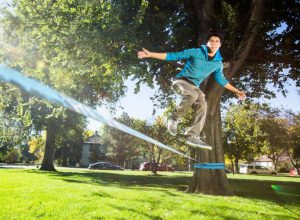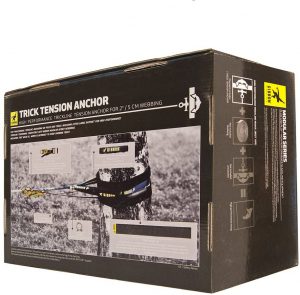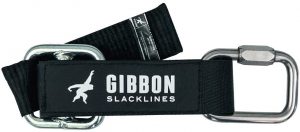
Slacklining is a sport that involves practicing balance moves on a tight, suspended medium. It is similar to tightrope walking but has more dynamic executions due to its elastic flexibility. Synthetic webbing is stretched between two anchor points, preferably trees. It is used for balance training, concentration, acrobatics, and fitness programs based on various tricks and stunts.
Slacklining is basically an umbrella term that branches out into different interests such as trickline, waterline, highline, yogaline, and rodeoline. It is the free-style nature of this sport that makes it a multifaceted outdoor hobby for adventure seekers who like to add their own creative twists.
Organizations like the International Slackline Association and Slackline US work to empower slackline communities through safety ethics and resourceful education. This includes risk assessment practices and gear standards that ensure safe environments for slackliners.
Stretching Back to the Origins
Slacklining dates back to the early 1980s when two Yosemite Valley climbers, Adam Grosowsky and Jeff Ellington, improvised their climbing gear into the first-ever slacklining experience.
The idea eventually grew popular as an outdoor recreation sport, and slacklining kits started being launched in the early 2000s to promote the activity.
The versatility of slacklines allowed them to be powerful balance training tools. The principle behind staying balanced on suspended elastic went on to become a game-changer in physiotherapies and public recreation.
Slacklining just includes beginner walking and balancing techniques that evolve into more complex maneuvers like those achieved on a trickline.
What is Trickline?
Extension to Slackline
Trickline is a fun way to revamp basic slacklining skills by incorporating gymnastics and acrobatics. The stretchy webbing material acts as a narrow trampoline, allowing trickliners to jump, bounce, and spin. Several other creative stunts can be practiced using balance and focus to remain stable. This makes tricklining an independent experience that helps you find your balance and physical freedom while dancing with gravity. Trickliners often design their own elaborate sequences and enjoy the adaptive possibilities of this sport.
Trickline Equipment
A tricklining kit is purpose-built to support the necessary tension that comes with complex performances on the line. In general, a heavy-duty trickline kit includes a 30 cm x 5 cm trickline, ratchets, a pulley system, a safe release strap, and slings. The ratchets help in creating a stronger tension along the trickline to support aerial stunts and create extra bounce.
There should be enough recommended distance between the two anchor points, otherwise, the trickline will remain stiff on impact. Proper setup and tension provide a trampoline effect, successfully responding to impacts and protecting your lower back and legs from injuries. A good trickline should help you land smoothly on the webbing.
Different Tricks
There is a whole library of standard tricks to perform on the line. Websites such as Slackline Industries help you learn the ropes to competitive slacklining through tutorial videos as a starting point. Tricklining is divided into several static and dynamic tricks.
All slackline and trickline stunts are normally classified under beginner, intermediate, advanced, and expert levels. Hobbyists can gradually warm up to different styles and work their way up the levels at their own pace. Serious athletes who love the adrenaline rush tend to pursue more complicated tricks and refine their balancing abilities.
Some of the most popular tricks include: drop knee, foot plant, back bounce, chest bounce, freefall 180/360, skydive, spiral, surfing, chest bounce to back bounce, ascension, and skyfall.
Trickline Products Wdorth Exploring
Gibbon Slacklines Trick Tension Anchor, with extra big ratchet, for advanced trickline setup, compatible to any 2″ wide trickline from GIBBON, with XL treewear, maximum safety thanks to back-up line

Gibbon Slacklines is renowned for its pioneering advances in the art of slacklining. Gibbon trickline kit includes all tricklining essentials like ratchets, shackles, and backup lines. The XXL power ratchet is ideal for creating more tension along the trickline, and Velcro supports make it easy to set up the equipment. The black-coated areas on the ratchet are safe to touch while handling and assembling. It has efficient overall ergonomics that make the experience more user-friendly during rigging and adjusting. Gibbon flat webbing is purpose-built to achieve the trampoline effect and provides superior orientation along the line. The anchor system provides maximum safety and resilience by exploiting the backup line as a redundant safety mechanism.
Gibbon Slacklines Slow Release Trickline Equipment, Perfect Solution for Smooth and Material-Friendly detensioning of The Slackline

Gibbon’s slow-release trickline equipment allows safe release for tricklines that are under high tension. The device is compatible with all kinds of Gibbon slacklines and tricklines. It offers practical and usable functionality during disassembling. Since the webbing material has been stretched to its maximum potential and elastic limit, the trickline must always be released safely to prevent it from rebounding at the user. Gibbon’s slow-release device speeds up installation and allows you to safely de-tension your trickline. Smooth transitions greatly affect the longevity and elasticity of the webbing material.
Why Tricklining is a Productive Leisure Pursuit
Coordinative Growth
Slackliners jump, flip, and balance their way through this elastic learning curve that teaches them coordination and discipline. Physical exercise combined with mental contribution to perfect each trick helps you bridge gaps in personal competence.
Overcoming Obstacles
The art of finding balance as you choreograph your moves with gravity makes a bold statement to silence your insecurities. Just like ballet and surfing help people discover creative outlets, tricklining also creates a sense of accomplishment at every step. It conditions your mind into believing that if you can defy gravity for a few seconds, you can surely overcome any problem with both feet on the ground.
Professional Uplifting
Learning with qualified instructors is a great way to understand how slacklining and environment are mutually related. Certified trainers teach you fundamental ethics like proper gear safety and fitness aspects. Accredited course providers like the International Slackline Association offer learning and volunteer opportunities that push your recreational interests to their pinnacle.
Beneficial to Other Sports
Improved balance exponentially increases your overall sports performance. Activities such as surfing, rock climbing, and endurance running derive long-lasting benefits from slacklining. Athletes often take up slacklining as part of their training regimens. This is because all the muscles come into action when you walk the fine line between physical and mental wellbeing.
